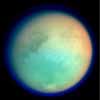| . |  |
. |
NASA's Cassini spacecraft successfully flew by Saturn's moon Titan at a distance of 2,402 kilometers (1,493 miles) on Thursday, March 31. Cassini's multiple instruments are providing new views of the haze-enshrouded world. On this recent flyby, Titan's haze was the focus of ultraviolet observations. By mapping the haze, scientists hope to learn about particle size and properties. Titan's transient clouds were also studied during the flyby. Titan's northern hemisphere was previously imaged with Cassini's radar instrument in October 2004 and February 2005. This time, Cassini's optical cameras got their best view of the same area, as did the visual and infrared mapping spectrometer. Titan is a prime target of the Cassini-Huygens mission because it is the only moon in our solar system with a thick, smoggy atmosphere. Cassini was launched over seven years ago and has traveled 3.55 billion kilometers (2.2 billion miles). All 12 of Cassini's instruments have been returning data, including tantalizing images. Recently, scientists noticed episodic interferences on the composite infrared spectrometer that were traced back to the time of orbit insertion.
A motor on one of three sensors on the magnetospheric imaging instrument and another motor on the plasma spectrometer are also not working properly. However, a workaround has been identified for the latter. All three instruments continue to function, although with some reduced level of science data collection. "We are working to understand why the instruments are not performing properly but it is likely to be a few weeks before we have definitive answers," said Robert T. Mitchell, Cassini program manager at NASA's Jet Propulsion Laboratory. "When running a mission for this long, you expect to have a few glitches. Cassini has been working remarkably well considering the duration and complexity of the mission." Cassini's next encounter is with Titan on April 16 at an altitude of 1,025 kilometers (637 miles). This will be Cassini's closest flyby of Titan yet. Related Links Cassini-Huygens at JPL Cassini Imaging Team SpaceDaily Search SpaceDaily Subscribe To SpaceDaily Express  Pasadena CA (JPL) Mar 31, 2005
Pasadena CA (JPL) Mar 31, 2005This map of Titan's surface illustrates the regions that will be imaged by Cassini during the spacecraft's close flyby of the haze-covered moon on March 31, 2005.
|
| |||||||||||
| The content herein, unless otherwise known to be public domain, are Copyright 1995-2016 - Space Media Network. All websites are published in Australia and are solely subject to Australian law and governed by Fair Use principals for news reporting and research purposes. AFP, UPI and IANS news wire stories are copyright Agence France-Presse, United Press International and Indo-Asia News Service. ESA news reports are copyright European Space Agency. All NASA sourced material is public domain. Additional copyrights may apply in whole or part to other bona fide parties. Advertising does not imply endorsement, agreement or approval of any opinions, statements or information provided by Space Media Network on any Web page published or hosted by Space Media Network. Privacy Statement All images and articles appearing on Space Media Network have been edited or digitally altered in some way. Any requests to remove copyright material will be acted upon in a timely and appropriate manner. Any attempt to extort money from Space Media Network will be ignored and reported to Australian Law Enforcement Agencies as a potential case of financial fraud involving the use of a telephonic carriage device or postal service. |